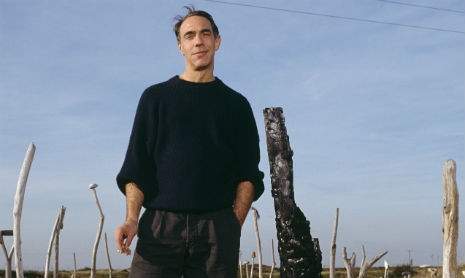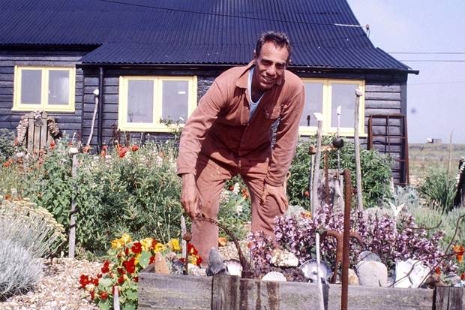
In his latter years, the film-maker, artist, diarist and writer Derek Jarman bought a small cottage on the shingle beach at Dungeness, in south-east England. It was a place of respite, a studio where he could write and paint, and a setting in which he created a beautiful garden amid the harsh, sea-lashed landscape.
Jarman first saw Prospect Cottage “on a springtime drive through Kent for a bluebell wood to Super-8 for the film which would become The Garden” in 1986. His partner, Keith Collins (HB) described the discovery of the cottage in the preface to Derek Jarman’s Garden:
Derek suggested eating at the Pilot Inn, Dungeness—renowned for serving ‘Simply the finest fish and chips in all England’.
Charmed by the landscape, we decided to visit the old lighthouse. Derek said: ‘There’s a beautiful fisherman’s cottage here, and if ever it was for sale, I think I’d buy it.’ As we neared the cottage, black varnished with bright yellow window frames, we saw the green-and-white ‘For Sale’ sign—the improbability of it made the purchase inescapable.
Jarman described the cottage in his collected journals Modern Nature:
Prospect Cottage, its timbers black with pitch, stands on the shingle at Dungeness. Built eighty years ago at the sea’s edge—one stormy night many years ago waves roared up to the front door threatening to swallow it… Now the sea has retreated leaving bands of shingle. You can see these clearly from the air; they fan out from the lighthouse at the tip of the Ness like contours on a map.
Prospect faces the rising sun across a road sparkling silver with sea mist. One small clump of dark green broom breaks through the flat ochre shingle. Beyond, at the sea’s edge, are silhouetted a jumble of huts and fishing boats, and a brick kutch, long abandoned, which has sunk like a pillbox at a crazy angle; in it, many years ago, the fishermen’s nets were boiled in amber preserve.
There are no walls or fences. My garden’s boundaries are the horizon. In this desolate landscape the silence is only broken by the wind, and the gulls squabbling round the fishermen bringing in the afternoon catch.
There is more sunlight here than anywhere else in Britain; this and the constant wind turn the shingle into stony desert where only the toughest grasses take a hold—paving the way for sage-green sea kale, blue bugloss, red poppy, yellow sedum.

Inside: Prospect cottage had four rooms. Jarman called his writing room and bedroom the “Spring room” a 10-foot by 12-foot space of “polished tongue and groove with a single window facing the sea.”
In front of the window is my desk: a simple 18th century elm table. On it is a reading lamp of tarnished copper, two pewter mugs full of stamps, loose change, paper clips, several bottles of ink, and pens, envelopes, scraps of paper on which to make notes for this diary, an iron spittoon used as an ashtray; in the centre a lead tobacco box in the shape of a little Victorian cottage, in which I keep my chequebook and money.
The cottage was overlooked by Dungeness nuclear power station that loomed like “a great ocean liner moored in the firmament, ablaze with light: white, yellow, ruby.”
Jarman started work on his garden “accidentally” from the “beach-combed treasures” found on the shore at low-tide. With the arrival of his friend the photographer and “keen plantsman” Howard Sooley Jarman’s plans for his sea-sprayed, shingle garden progressed:
[Howard] gave up London weekends to chauffeur Derek—via the nurseries of the south of England—to Prospect Cottage. With his collaboration the garden entered its second phase: the unexpected success of new plants and bulbs, flint and scallop-shell edged beds, honey bees enclosed in a raised herb bed, and more seashore-rusted metal and wind-twisted wood.
In the mid-1980s, Jarman had been diagnosed as HIV-positive. As the illness took hold, Jarman’s work in the garden took on a new meaning:
...the plants struggling against the biting winds and Death Valley sun merged with Derek’s struggle with illness, then contrasted with it, as the flowers blossomed while Derek faded.
Howard Sooley photographed Derek Jarman’s garden from the first day he arrived at Prospect Cottage in 1989, when the land looked like the surface of the Moon. Sooley documented Jarman’s unstinting hard work that changed the garden from shingle shore to hardy burst of beauty and color. Most recently, Sooley made this film about Jarman’s garden for Nowness, and together with Keith Collins he continues to tend to Derek Jarman’s last great living artwork.